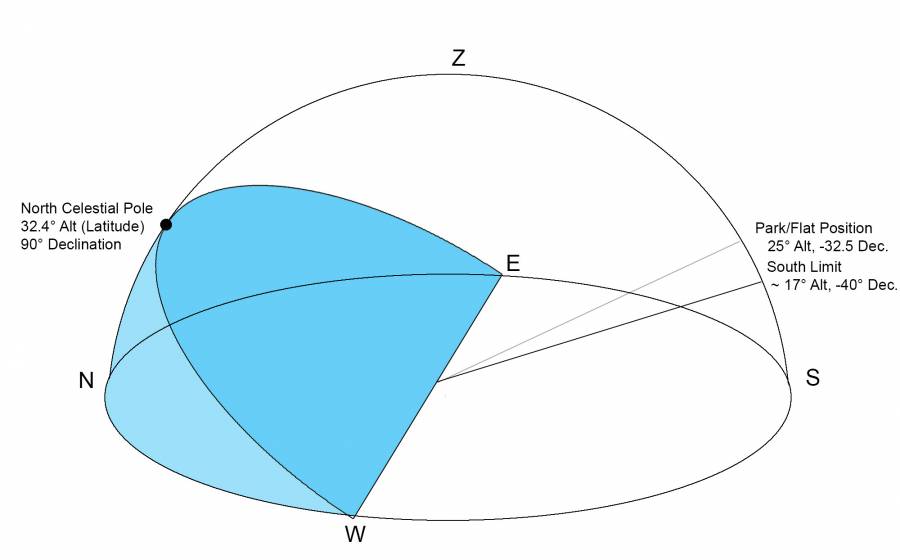Table of Contents
Schulman Telescope Limits
The telescope has both mechanical limits and software limits in place. For purposes of this document the mechanical limits are defined by the diagram below (please refer to it in the following discussion). The software limits imposed on the system by the LCOGT software are effectively the mechanical limits on each axis. Other programs such as ACP have software limits that are adjustable. Generally these are either set to be very close to the mechanical limits or in some positions represent when the mirror is more than 50% occulted by the dome wall.
Declination
- The telescope will swing below the celestial pole and slightly beyond horizontal with the ground (when on the meridian) until it reaches the north hard stop (actually a rubber stop). This limit is called “L1 Positive” and it is the position reached in the course of homing the telescope. Often this position is a good one to clean the primary mirror, work in the truss box, and unfortunately clear a focuser jam.
- The southern hard stop is just before the position where the truss supports collide with the inside of the fork arms. It is roughly 8 degrees below the Park/Flat position. The Flat position is at telescope elevation of 25 degrees so that the front of the telescope is planar with surface of the flat panel.
Hour Angle
The hour angle hard stops are roughly at +/- 5.3 hours. This has an “interesting” consequence that there is a portion of the sky that is unattainable because of these limits. On the celestial equator (declination of 0°) the telescope can point to the horizon at nearly the E/W points. As position moves towards greater declination for an hour angle of +/-5.3, the zone of inaccessibility rises until it reaches the pole at 32 degrees in elevation above the horizon. Thus objects rising and above the horizon in the northeast are not possible to observe until the hour angle is greater than 5.3. The diagram below indicates the shape of this zone of inaccessibility (colored blue). For visual observations occasionally an object is near the boundary of this zone. Pointing the telescope at the position with the correct declination but into the 5.3 hour angle limit with the hand paddle will turn the tracking off. The observer can simply wait for the Earth to turn and the object will enter the field of view. Then with the paddle jog the telescope out of the limit to resume tracking (the object). When using the telescope remotely or during autonomous observing- commanding the telescope to point beyond this limit will generate an error. Depending on the geometry, this error will allow the system to continue (by skipping the observation) or require a restart of the software. No physical damage will result in pointing the telescope to limit or beyond. Limit switches turn off the servos at the hard limits.
Notes
When the telescope as at a limit the position is undefined and tracking stops. Consequently anything that requires a position will likely not work. For example connecting ACP to the telescope while it is in the home position can be an issue.


